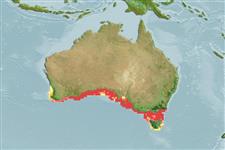>
Scombriformes (Mackerels) >
Arripidae (Australian salmon)
Etymology: Arripis: Latin, arripio, arripere = to take something suddenly.
More on author: Cuvier.
Environment: milieu / climate zone / rango de profundidad / distribution range
Ecología
marino; salobre bentopelágico; rango de profundidad 0 - 80 m (Ref. 6390). Subtropical; 27°S - 44°S
Eastern Indian Ocean: southern Australia from Western Australia to Victoria and Tasmania.
Length at first maturity / Tamaño / Peso / Age
Madurez: Lm ?, range 54 - ? cm
Max length : 96.0 cm SL macho / no sexado; (Ref. 33839); common length : 65.0 cm FL macho / no sexado; (Ref. 27977); peso máximo publicado: 10.5 kg (Ref. 27977); edad máxima reportada: 9 años (Ref. 27977)
Short description
Claves de identificación | Morfología | Morfometría
Espinas dorsales (total) : 9; Radios blandos dorsales (total) : 15 - 19; Espinas anales: 3; Radios blandos anales: 9 - 10; Vértebra: 25. Greyish or greenish black to steel-blue with yellow to blackish spots dorsally; silvery white ventrally. Pectoral fin pale yellowish, other fins translucent. Juveniles similar but with a greater number of spots and with dark fin margins. Length of upper lobe of caudal fin <29.9% (Ref. 9701).
Body shape (shape guide): fusiform / normal; Cross section: compressed.
Inhabit continental shelf waters including estuaries, bays and inlets (Ref. 6390). They school in shallow, open coastal waters, and can move over reefs in depths just sufficient to cover their bodies (Ref. 6390). Juveniles are found over soft substrates in shallow and sheltered coastal waters (Ref. 6390). They are often found over seagrass (e.g. Posidonia species) beds and in mangrove-lined (Avicennia species) creeks (Ref. 27967). Larger fish move into exposed, coastal waters, such as around rocky headlands, near reefs and the surf zone (Ref. 6390). Feeds on fishes (Ref. 2156). Minimum depth reported taken from Ref. 57178.
They are probably serial batch spawners (Ref. 6390).
Paulin, C., 1993. Review of the Australian fish Family Arripididae (Percomorpha), with the description of a new species. Aust. J. Mar. Freshwat. Res. 44(3):459-471. (Ref. 9701)
IUCN Red List Status (Ref. 130435: Version 2025-1)
Human uses
Pesquerías: comercial; pesca deportiva: si; carnada: usually
Herramientas
Special reports
Download XML
Fuentes de Internet
Estimates based on models
Preferred temperature (Referencia
123201): 15 - 18.5, mean 17.1 °C (based on 162 cells).
Phylogenetic diversity index (Referencia
82804): PD
50 = 0.6250 [Uniqueness, from 0.5 = low to 2.0 = high].
Bayesian length-weight: a=0.01122 (0.00514 - 0.02450), b=3.04 (2.87 - 3.21), in cm total length, based on all LWR estimates for this body shape (Ref.
93245).
Nivel trófico (Referencia
69278): 4.4 ±0.75 se; based on food items.
Resiliencia (Referencia
120179): Medio, población duplicada en un tiempo mínimo de 1.4-4.4 años (K=0.26-0.30; tm=3-6; tmax=9).
Fishing Vulnerability (Ref.
59153): Moderate to high vulnerability (48 of 100).
🛈
Nutrients (Ref.
124155): Calcium = 35.7 [22.2, 62.5] mg/100g; Iron = 0.755 [0.498, 1.167] mg/100g; Protein = 19.8 [17.7, 21.8] %; Omega3 = 0.361 [0.228, 0.572] g/100g; Selenium = 30.2 [16.9, 52.3] μg/100g; VitaminA = 18.9 [7.6, 48.3] μg/100g; Zinc = 0.591 [0.446, 0.808] mg/100g (wet weight);
